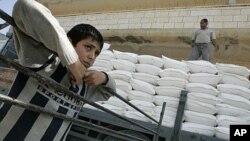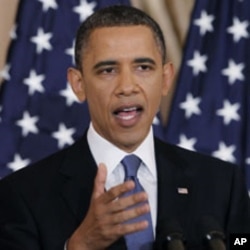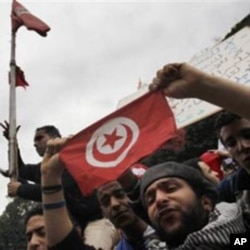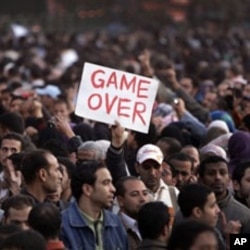When lawmakers in the U.S. Congress began discussing how much foreign aid to give Middle East countries in 2012, their own debt crisis loomed large. Republicans in the House of Representatives proposed big cuts in overall American commitments. Yet the Arab Spring lifted the democratic hopes of millions in the Middle East and has presented Congress with bigger questions about how to invest in the political futures of Egypt, Lebanon, the West Bank and Gaza, for example.
When Congress returns from a month’s recess in early September, lawmakers will look again for reductions in international aid. They do so at a crucial time when many countries may need assistance in their transition from revolution to democracy. Budget reductions will still be discussed, but global social and political objectives remain the driving force. Analysts say it will be hard for lawmakers in Washington to decide which countries in the Middle East are going to be good democratic bets.
Curbed ambitions
President Barack Obama set the stage for strong Middle East commitments before an audience of Foreign Service officers on May 19, just two weeks after the killing of Osama bin Laden. “The effort begins in Egypt and Tunisia, where the stakes are high, as Tunisia was at the vanguard on this democratic wave, and Egypt is both a longstanding partner and the Arab world’s largest nation,” the President said.
Obama later proposed $50.9 billion in international assistance with a modest increase over 2011 funding. Significant levels were requested for operations and assistance in Iraq, Afghanistan, and Pakistan.
Recently, however, the House Foreign Affairs Committee voted 23 Republicans to 20 Democrats to authorize a $6.4-billion reduction of the president’s international assistance budget. The committee addressed policy issues in the climate of budget deficits. Congresswoman Ileana Ros-Lehtinen, the committee chair, addressed the Middle East issue when the House bill was passed.
She said the committee reaffirmed its “unwavering support for our ally Israel,” and proposed restrictions on Egypt, Lebanon, Yemen and the Palestinian Authority: President Obama must certify that “Hezbollah, Hamas and other terrorist groups hold no policy positions in these governments.”
“If I could characterize the House effort,” says James Carafano of the Heritage Foundation, a think tank close to Congressional conservatives, “it really is trying to get beyond writing a blank check and using it as a blunt instrument, and really trying to make sure that foreign assistance is supporting American policies.”
Aid based on performance
Carafano says Congress should address foreign aid country-by-country based on the business principle of “pay for performance:” invest when you’re sure you will get the return you want. Especially in countries like Egypt and Pakistan. Carafano, who is vice president of the Heritage Foundation’s foreign and defense policy studies, considers foreign assistance “an instrument of national power.” He uses the U.S. government’s Millennium Challenge Account as the model for the “pay for performance” philosophy and prefers it to what he calls “the traditional foreign assistance of just funneling money into there.”
However, that model of measurement cannot be easily applied to Egypt before its elections, for example. Carafano admits, “It’s very very difficult with all the turmoil in the Arab Spring to have a clear vision of where can I put my money to help the forces of freedom and free markets move in the right direction because it’s hard to see where the institutions are.”
That means Congress may have to wait longer to see what happens in Cairo and other capitals. “I just see two years of muddling through,” he said. “Particularly in this region.”
The wisdom of cuts
Chairwoman Ros-Lehtinen also said that the committee’s proposed cuts would save billions.
However, Sam Worthington, the CEO of InterAction, says cutting foreign assistance can’t solve U.S. debt problems because it’s only one percent of the budget. “The reality is that the savings won’t be there and the pain and the long-term consequences of the cuts will be quite significant.” InterAction is the world’s largest alliance of U.S.-based international NGOs. Its members implement many of the U.S. aid programs overseas. CHF International, the International Foundation for Electoral Systems, and International Relief and Development are among major InterAction organizations conducting elections projects in such countries as Afghanistan, Egypt, Iraq, Lebanon, Tunisia, as well as in the West Bank and Gaza.
Worthington’s concern, however, is also global and speaks to Republican proposals to cut the operating budget of the U.S. Agency for International Development (USAID) , and obligations to the United Nations and other international agencies: “These cuts will not only harm U.S. national interests, they will have a huge impact on the lives of those who are already marginalized in the poorest corners of the earth,” he said..
Nevertheless, Worthington is optimistic about Middle East funding. “My sense is that there will be strong pressures to have additional investments in the Middle East. In this case, I do believe the Middle East merits that additional attention.”
Others focused on the political and economic growth of the Middle East aren’t that optimistic.
”You don’t have to be an experienced Congress watcher to know that the sentiment in Congress is all for preserving the Defense budget and slicing [the] State [Department] and USAID,” said Daniel Serwer, a scholar at the Middle East Institute and lecturer at Johns Hopkins University’s School of Advanced International Studies. “When it’s time to cut the federal budget, international assistance is a target.”
Past aid distribution
Since the leaders of Israel and Egypt signed the Camp David Accords 33 years ago, the second-largest U.S. military and economic aid package each year has gone to Egypt. The Congressional Research Service reports that Egypt’s share per year has averaged $2 billion in economic and military aid. For this year, the military portion was $1.3 billion, and the economic package was $250 million.
The bulk of all U.S. foreign assistance to Egypt in 2011 falls under “peace and security” issues: $1.3 billion are earmarked to fight terrorism, trafficking in narcotics and people, and weapons of mass destruction, and for promoting conflict resolution. Much smaller amounts serve the domestic needs of a nation of approximately 93 million: economic development - $104 million; education and social services - $91 million; health - $30 million; democratization - $25 million.
What’s needed now
However, Serwer argues that now is the time to focus dollars and new civilian initiatives on Arab Spring countries like Egypt to address governments currently in transition.
“Where I would put more money is in politics and particularly in civil society, the kind of vigorous non-governmental organizations and advocacy organizations that will keep government honest. That’s what brought Mubarak down and that’s what’s going to keep Egypt on a democratic path. I would try to support the revolution,” said Serwer.
The new political landscape in Egypt is hard to analyze both in Washington and Cairo. “A bit of it is messy,” said Amr Hamzawy, a founder of one of Egypt’s new political parties, the liberal Free Egypt. “It’s a new game. We are humbled by the moment of change and wait and see.”
Hamzawy returned home recently after five years with the Carnegie Endowment for International Peace in Beirut and Washington and has spent many evenings at the protests on Cairo’s Tahrir Square, where Egyptians have been debating the political way forward.
Hamzawy has heard almost no anti-U.S. talk on the streets of Cairo. “We are pre-occupied with our own stuff now. We are looking inward. We have much to try to account for realizing the scale of the big mess Mubarak has left us with.”
Mustafa Kamel Al-sayed, a political science professor at the University of Cairo, isn’t worried about the possible loss of aid from the United States.
“I think the amount of U.S. economic assistance to Egypt is really trivial,” said Al-sayed. He estimated that it amounts to less than one percent of Egypt’s gross national product. “I don’t think the cut of this amount of aid will be a catastrophic event for the Egyptian government.”
But he did add a caveat: “I think it will increase hostility towards the U.S. and will reinforce the negative image Egyptians and Arabs have of U.S. foreign policy and Congress in particular.”
Aid as a means toward security
Serwer’s skepticism of U.S. aid commitments is shared by others in Washington. “I think we’re going to face increasing struggles over the budget because of the size of the deficit,” said Howard, a former director of USAID programming in the West Bank and Gaza. Sumka now heads OneVoice, a non-profit that promotes a two-state solution for Palestinians and Israelis. “I would hope that foreign assistance is not treated like an easy hit by anybody. It usually is, so I don’t have too much reason to be optimistic,” said Sumka.
Sumka recently visited the Ramallah office of Palestinian prime minister, Salaam Fayyad, whose West Bank administration had run out of money and was unable to pay the salaries of government workers. Fayyad told Sumka their immediate crisis was that Arab states had failed to come through on their own foreign aid commitments.
In its support of a two-state solution, the U.S. government is spending $513 million in the current fiscal year on aid in the West Bank and Gaza. Approximately half goes toward education and social services. The balance is divided between economic development, health, democratization, humanitarian assistance, and peace and security.
“The assistance we provide to foreign countries is very directly related to the security we face,” said Sumka. “We need to be very conscious as a country of supporting our friends, building democracy and keeping the focus on the connection between development and counter-terrorism and our own security. We renege on our international commitments really at our own security risk.”










